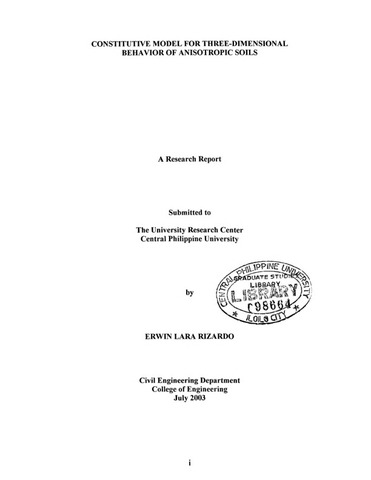Показать сокращенную информацию
Constitutive model for three-dimensional behavior of anisotropic soils
| dc.contributor.author | Rizardo, Erwin L. | |
| dc.date.accessioned | 2021-05-28T01:02:00Z | |
| dc.date.available | 2021-05-28T01:02:00Z | |
| dc.date.issued | 2003-07 | |
| dc.identifier.citation | Rizardo, E. L. (2003). Constitutive model for three-dimensional behavior of anisotropic soils (Research report). Jaro, Iloilo City: University Research Center, Central Philippine University. | en_US |
| dc.identifier.uri | https://hdl.handle.net/20.500.12852/909 | |
| dc.description | Abstract only | en_US |
| dc.description.abstract | This was conducted to study the theory of “Multi-Directional Sliding Model” and verify its application with some series of element tests available for the stress condition with principal stress axis. Specifically, it aimed to study the inherent and induced anisotropic deformation-failure behavior of sand in general stress condition with the rotation of principal stress axis; and to evaluate and verify the model for sand with inherent and induced anisotropy. A series of drained shear tests with the rotation of the principal stress axis are conducted on sand with inherent anisotropy using a hollow cylindrical torsional shear apparatus. The following points are clarified from the observation of deformation behavior of sand with and without the preshearing and stress loading history. Inherent anisotropy on the mechanical properties of sand induced during deposition of sand particles in the specimen preparation process has notable effect on shear strength, shear deformation and dilatancy behavior. Shear strength and shear stiffness are both maximum at principal stress direction 2a equal to 0° and maximum at 2a equal to 150°. The induced anisotropy of sand has notable influence on shear behavior and dilatancy behavior observed in the reloading process after preshearing. Shear strain and volumetric strain generated in the reloading process increases and decreases, respectively due to preshearing depending on the relative direction of principal stress. Shear stress paths observed in reloading process are also affected by the induced. | en_US |
| dc.format.extent | xix, 120 leaves | en_US |
| dc.language.iso | en | en_US |
| dc.publisher | Central Philippine University | en_US |
| dc.subject.ddc | GSL 624.072 R528 | en_US |
| dc.subject.lcsh | Soils | en_US |
| dc.subject.lcsh | Sand | en_US |
| dc.subject.lcsh | Soil mechanics | en_US |
| dc.subject.lcsh | Soils--Analysis | en_US |
| dc.title | Constitutive model for three-dimensional behavior of anisotropic soils | en_US |
| dc.type | Technical Report | en_US |
| dcterms.accessRights | Limited public access | en_US |
| dc.description.bibliographicalreferences | Includes bibliographical references | en_US |
| local.subject | Anisotrophy | en_US |
| local.relation.associatedcontent | https://repository.cpu.edu.ph/handle/20.500.12852/708 Full paper published in Patubas | en_US |
Файлы в этом документе
Данный элемент включен в следующие коллекции
-
Research reports [13]
-
Research reports [167]


